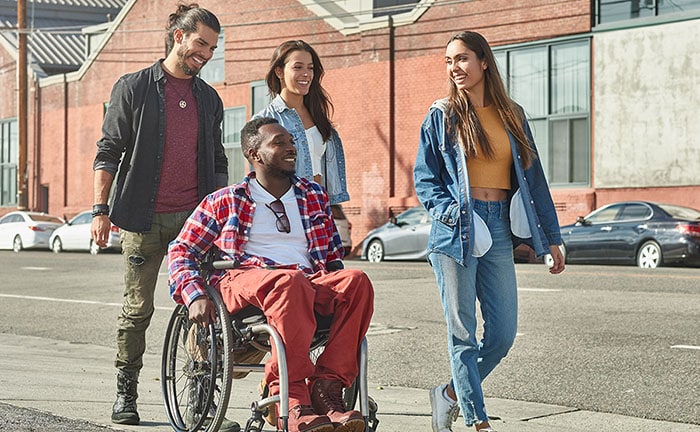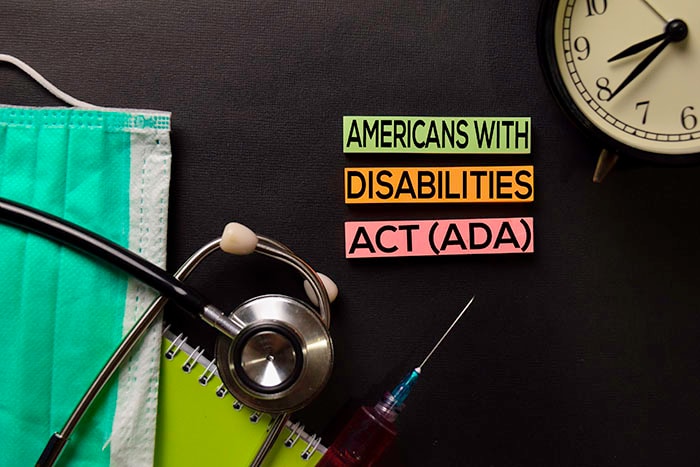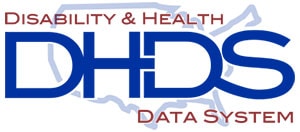30th ADA anniversary: Health is for all of us

July 26, 2020 marks the 30th anniversary of the Americans with Disabilities Act (ADA), a civil rights law that promotes the inclusion of people with disabilities in every aspect of life. Learn what CDC is doing to support disability inclusion, which can improve health for all.
Anyone can have a disability at any point in their life. Disabilities, which limit how a child or adult functions, may include serious difficulty with walking or climbing stairs; hearing; seeing; or concentrating, remembering, or making decisions. One of every four adults in the United States has some type of disability,1 and many people will experience a disability during their lifetime.
This month is the 30th anniversary of the Americans with Disabilities Act (ADA), a civil rights law that prohibits discrimination against individuals with disabilities in all areas of public life. The ADA has made a positive difference in the lives of those who have disabilities by providing better access to buildings, transportation, education, and employment and creating opportunities for individuals with disabilities to work, play, and contribute in their communities. However, challenges remain with access to health care, as well as inclusion of people with disabilities in health promotion and disease prevention programs.1
Additionally, people with disabilities continue to face significant differences in health compared to people who do not have disabilities. For example
- Adults with disabilities are three times more likely to have heart disease, stroke, diabetes, or cancer than adults without disabilities.2
- Adults with disabilities are more likely to smoke, have obesity, be physically inactive, and be diagnosed with depression than adults without disabilities.3
- Women with disabilities are less likely to have received a mammogram in the previous 2 years than women without disabilities.4
- Some people with disabilities might be at increased risk of being infected or having severe illness from COVID-19 because of their underlying medical conditions; they also might not be able to communicate symptoms of illness.

CDC Supports Disability Inclusion
CDC recognizes ADA as an important policy for facilitating the inclusion of people with disabilities in federal efforts related to health and health care. As such, CDC strives to improve the health of people with disabilities by providing access to disability data, fostering state and national collaborations to promote inclusion, and developing tools for disability inclusion. Below are some of our most recent resources and tools for disability inclusion.
Providing Access to Disability Data
Knowing the differences in health between people with and without disabilities is the first step in making sure people with disabilities have access to the programs and services that can help improve their health.
CDC created the Disability and Health Data System (DHDS) to provide vital information to better understand the health needs of adults with disabilities at the state and national levels. Equipped with these data, state epidemiologists, researchers, policymakers, public health professionals, and anyone interested in the health of adults with disabilities can plan for inclusive communities that offer the programs and services needed to improve the health of this population.
With DHDS, you can get answers to questions such as
- What is the percentage of adults with a disability in my state?
- How does the health of adults with disabilities vary by age, sex, and race/ethnicity?
- How does the health of adults with disabilities in my state compare to other states and the nation?
- How does the percentage of depression, diabetes, obesity, or smoking vary among people with select disability types?
Fostering State and National Collaborations
CDC funds the Association of State and Territorial Health Officials, the National Association of County and City Health Officials and the Association of University Centers on Disabilities through a project titled, “Addressing Needs of People with Disability in COVID-19 Preparedness, Planning, Mitigation, and Recovery Efforts in the United States.”
The purpose of this project is to ensure that the needs of people with disabilities are addressed in COVID-19 planning, mitigation, and recovery efforts through
- Development of preparedness and response plans by state, territorial, and city/county health departments that are inclusive of people with disabilities;
- Improved understanding of the unique healthcare service needs of people with disabilities before, during, and after a pandemic; and
- Partner engagement to share emergency preparedness and response resources on COVID-19 for people with disabilities.
Developing Tools for Disability Inclusion
People with disabilities need public health programs and healthcare services for the same reasons everyone does—to be healthy, active, and engaged as part of the community. Including people with disabilities in public health programs and activities ensures improvements in the overall health and wellbeing of the entire population. CDC provides resources that public health practitioners, healthcare providers, and others can use to help ensure that every person – with or without disabilities – can participate fully in their communities.
Visit the Inclusive Healthy Communities Model (IHCM) webpages to learn how ten communities in five states used IHCM to implement disability inclusion strategies and make healthy living easier for all people across community sectors where they live, learn, work, play, pray and receive care.
Listen to experts from these communities, watch videos of their success stories, and learn how you can also apply the IHCM in your community to promote inclusion and accessibility, and reduce health inequities among people with disabilities.
Moving Forward
CDC is committed to protecting the health and well-being of people with disabilities across their lifespans. The work of CDC honors the intent of the ADA as a critical piece of civil rights legislation to ensure people with disabilities receive essential healthcare services and programs, enjoy a high quality of life, experience independence in their communities, and reach their full potential.
References
- Okoro CA, Hollis ND, Cyrus AC, Griffin-Blake S. Prevalence of Disabilities and Health Care Access by Disability Status and Type Among Adults — United States, 2016. MMWR Morb Mortal Wkly Rep. 2018;67:882–887. https://www.cdc.gov/mmwr/volumes/67/wr/mm6732a3.htm
- Carroll DD, Courtney-Long EA, Stevens AC, et al. Vital Signs: Disability and Physical Activity – United States, 2009-2012. MMWR Morb Mortal Wkly Rep. 2014;63:407–13. https://www.cdc.gov/mmwr/preview/mmwrhtml/mm6318a5.htm
- Centers for Disease Control and Prevention, National Center on Birth Defects and Developmental Disabilities, Division of Human Development and Disability. Disability and Health Data System (DHDS) Data [online]. [Accessed June 12, 2020]. URL: https://dhds.cdc.gov.
- Courtney-Long E, Armour B, Frammartino B, Miller J. Factors Associated with Self-reported Mammography Use for Women with and Women Without a Disability. J Women’s Health (Larchmt). 2011; 20:1279–1286. DOI: 1089/jwh.2010.2609























.png)











No hay comentarios:
Publicar un comentario